Advanced SIMPLIS Training
|
In this Topic Hide
Every device model used in a SIMPLIS simulation uses Piecewise Linear (PWL) modeling techniques.
This topic picks up where topic 1.0.1 leaves off. After the simulation completes, the graph viewer displays multiple graph tabs. If you have closed the graph viewer or one of the graph tabs, run the simulation again to regenerate the graphs. The right-most two graphs are of interest, these two graph tabs will be similar to:
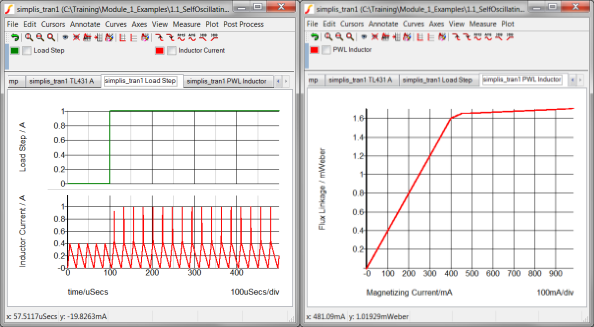
The left hand graph contains two curves, the Load Step in green, and the Magnetizing Inductor Current in red.
During the transient simulation, a one amp load step is applied at 100us. During this load step, the total load current transitions from a 2A full load condition to a 3A overload condition with the consequence that the transformer enters into saturation. The current limit function is triggered and the output voltage drops. The following graph is zoomed in on the first 200us of the simulation.
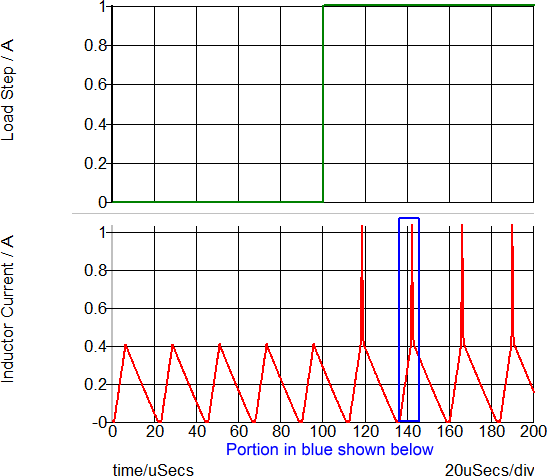
This overload condition demonstrates how a PWL inductor models the saturation of a transformer magnetizing inductance. The following two graphs show a close-up view of the time-domain magnetizing inductor waveform and the flux linkage versus current plane on which PWL inductors are defined. Each of these three PWL inductor segments can be seen in both the transient simulation results and in the x-y plot of the flux linkage versus current plane show below:
| Saturating Magnetizing Current | B-H Loop |
 |
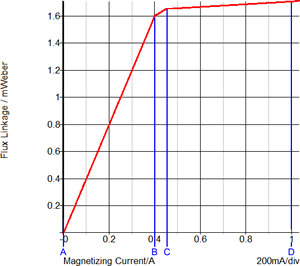 |
The saturation of this transformer is modeled with three PWL segments in the flux linkage versus current plane. Because the slope of this curve is the magnetizing inductance, the magnetizing inductance can take on three distinct values:
When the magnetizing current is below 0.4A, the normal or unsaturated magnetizing inductance of 1.6mWeber/0.4A equals 4mH is used.
The knee of saturation occurs when the magnetizing current is between 0.4 and 0.45A. The inductance in this region is (1.65m-1.6m)/(0.45-0.40) which equals 1mH.
The final PWL segment represents a "hard" saturation. The inductance of this segment is 100uH.
What about the Diodes or the MOSFET on the schematic? Are these PWL models as well? Yes!
As an example, the output rectifier in Self-Oscillating Converter has the following Forward Current and Forward Voltage curves during the transient simulation. The left hand graph has the Forward Current and Forward Voltage plotted vs. Time. In the right-hand graph, the Forward Current is plotted versus the Forward Voltage for this diode. The Blue curve is the 3 segment SIMPLIS PWL model. The red curve is the SIMetrix simulation results for SPICE model of the same diode.
| Voltage and Current vs. Time | Voltage vs. Current |
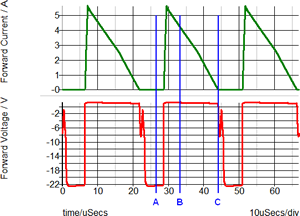 |
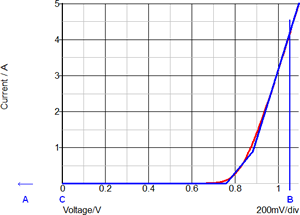 |
The annotated points describe the following diode states:
An in depth discussion of MOSFET modeling is presented in section 1.0.4 Multi-Level Modeling.
The table below illustrates how SIMPLIS represents PWL resistors, PWL capacitors, and PWL inductors as a set of PWL straight-line segments. A PWL resistor is piecewise linear in the current versus the voltage plane. The slope of this curve is the conductance. SIMPLIS automatically extends the left-most and right-most PWL segment to negative and positive infinity, respectively.
PWL capacitors are defined on the charge versus voltage plane where the slope is capacitance. PWL inductors are defined on the flux-linkage versus current plane, where the slope is inductance. The units of flux linkage are Weber-Turns or volt-seconds.
| PWL Resistor | PWL Capacitor | PWL Inductor |
|
|
|
|
|
|
x-value ⇒ Voltage |
x-value ⇒ Voltage |
x-value ⇒ Current |
y-value ⇒ Current |
y-value ⇒ Charge |
y-value ⇒ Flux Linkage |
Slope=1/Resistance |
Slope=Capacitance |
Slope=Inductance |
◀ 1.0.1 SIMPLIS is a time-domain simulator, all the time, for every analysis, period |
© 2015 simplistechnologies.com | All Rights Reserved